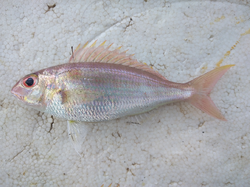Biology:Nemipterus peronii
| Nemipterus peronii | |
|---|---|

| |
| Scientific classification | |
| Domain: | Eukaryota |
| Kingdom: | Animalia |
| Phylum: | Chordata |
| Class: | Actinopterygii |
| Order: | Spariformes |
| Family: | Nemipteridae |
| Genus: | Nemipterus |
| Species: | N. peronii
|
| Binomial name | |
| Nemipterus peronii (Valenciennes, 1830)
| |
| Synonyms[2] | |
| |
Nemipterus peronii, the notchedfin threadfin bream, notchedfin butterfly bream rosy threadfin bream or Peron's threadfin bream, is a species of marine ray-finned fish belonging to family Nemipteridae, the threadfin breams. This species occurs in the Indo-West Pacific region.
Taxonomy
Nemipterus peronii was first formally described in 1830 as Dentex peronii by the French zoologist Achille Valenciennes, Valenciennes did not give a type locality but it is thought to be Northwestern Australia.[3] The 5th edition of Fishes of the World classifies Nemipterus within the family Nemipteridae which it places in the order Spariformes.[4]
Etymology
Nemipterus peronii has a specific name which honours the collector of the type, the French voyager and naturalist François Péron.[5]
Description
Nemipterus peronii has its dorsal fin supported by 10 spines and 9 soft rays while the anal fin contains3 spines and 7 soft rays.[2] The spines of the dorsal fin are elongate and there is a deep notch between the spiny part of the dorsal fin and the soft rayed part. Its body has a standard length that is 3.1 to 4.1 times its depth and it has a snout that is roughly equal in length to the diameter of the eye. There are 3 or 4 pairs of canine-like teeth in the front of the upper jaw.[6] The short pectoral fins do not reach the anus while the moderately long pelvic fins extend to the level of the anus. The caudal fin has a deep fork with the upper lobe being pointed and a little longer than the lower lobe. The colour of the upper body is pinkish marked with 7 or 8 vaguely delineated pink saddle marks extending as far as or a little beyond the lateral line. The lower body is silvery with the scale rows being marked with indistinct golden lines. There is a vague reddish spot just below the front end of the lateral line. The snout has a golden line on it that passes through the nostrils. There is a silvery-purple area underneath the eye and the preoperculum and operculum have a golden sheen. The dorsal fin has an overall colour of pale whitish pink, with a light yellow line or row of spots just over its base and the tips of the spines are orange. The anal fin has a similar colour to the dorsal but has a yellow tint on its central part. The caudal fin is pinkish, the pelvic fins are white with a yellow scale at their bases and the pectoral fins are transluscent.[6] The maximum published standard length of this fish is 29 cm (11 in), although 17 cm (6.7 in) is more typical.[2]
Distribution and habitat
Nemipterus peronii isfound in the Indian and Pacific Oceans. It occurs in the Red Sea, Persian Gulf, along the coasts of Pakistan, India and Sri Lanka east into the Western Pacific where it reaches north to southern Japan and south to Australia.[1] There is some confusion between this species and N. furcosus and the presence of either species off New Caledonia was still in need of confirmation in 2011.[7] The notchedfin threafin bream is found on sandy and muddy substrates at depths between 17 and 100 m (56 and 328 ft).[2]
Biology
Nemipterus peronii feeds on fishes, crustaceans, polychaetes and molluscs. It is typically encountered in rather nervous groups during the daylight hours. It has 2 extended spawning season in the South China Sea, one in November to February and the other beginning in May or June.[2]
Fisheries
Nemipterus peronii is caught using hand lines and Bottom trawling, the catch is often a mixed catch with other threadfin breams. There is a commercial fishery for this species in the Straits of Malacca and in the South China Seaoff the coast of Terengganu in Malyasia. This species is found in small numbers in local fish markets may be sold either fresh or dried-salted.[1]
References
- ↑ Jump up to: 1.0 1.1 1.2 Russell, B.; Smith-Vaniz, W.F.; Lawrence, A. (2016). "Nemipterus peronii". IUCN Red List of Threatened Species 2016: e.T46087000A46664769. doi:10.2305/IUCN.UK.2016-3.RLTS.T46087000A46664769.en. https://www.iucnredlist.org/species/46087000/46664769. Retrieved 7 November 2023.
- ↑ Jump up to: 2.0 2.1 2.2 2.3 2.4 Froese, Rainer and Pauly, Daniel, eds. (2023). "Nemipterus peronii" in FishBase. June 2023 version.
- ↑ Eschmeyer, William N.; Fricke, Ron; van der Laan, Richard, eds. "Species in the genus Nemipterus". California Academy of Sciences. http://researcharchive.calacademy.org/research/ichthyology/catalog/fishcatget.asp?tbl=species&genus=Nemipterus.
- ↑ Nelson, J.S.; Grande, T.C.; Wilson, M.V.H. (2016). Fishes of the World (5th ed.). Hoboken, NJ: John Wiley & Sons. pp. 502-506. doi:10.1002/9781119174844. ISBN 978-1-118-34233-6. OCLC 951899884.
- ↑ "Order SPARIFORMES: Families LETHRINIDAE, NEMIPTERIDAE and SPARIDAE". The ETYFish Project Fish Name Etymology Database. Christopher Scharpf. 17 October 2022. https://etyfish.org/spariformes/.
- ↑ Jump up to: 6.0 6.1 B. C. Russell (2001). "Nemipteridae". The Living Marine Resources of the Western Central Pacific Volume 5: Bony fishes part 3 (Menidae to Pomacentridae). FAO Species Identification Guide for Fishery Purposes. FAO Rome. p. 3063. https://www.fao.org/3/y0770e/y0770e29.pdf.
- ↑ Ronal Fricke; Michel Kulbicki; Laurent Wantiez (2011). "Checklist of the fishes of New Caledonia, and their distribution in the Southwest Pacific Ocean (Pisces)". Stuttgarter Beiträge zur Naturkunde A, Neue Serie 4: 341–463. https://horizon.documentation.ird.fr/exl-doc/pleins_textes/divers14-04/010061070.pdf.
Wikidata ☰ Q1890330 entry
 |


